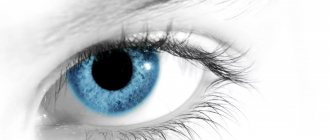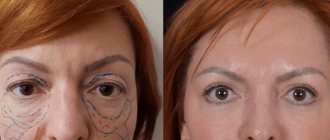Laser blepharoplasty — eyelid surgery using a laser, which allows you to restore youth and beauty to the eye area of patients of all ages.
In the photo: a patient before and after circular blepharoplasty of the upper and lower eyelids 1 week after surgery
The laser helps make blepharoplasty surgery less traumatic and virtually bloodless, because it cauterizes small vessels and minimizes the appearance of hematomas and swelling after surgery.
Laser eyelid blepharoplasty has become popular due to the high degree of patient satisfaction with the results of the operation compared to traditional surgery.
If you want to restore youth to your eyes , are tired of bags under your eyes, puffiness, wrinkles and drooping eyelids - sign up for a free consultation - this is how you will take the first step towards perfection.
Blepharoplasty of eyelids - before and after
In the photo: Blepharoplasty of the upper eyelids before and after
Circular blepharoplasty, The result is presented 1 week after surgery
In the photo: Blepharoplasty of the upper eyelids, 3/4 view
See more photos before and after eyelid blepharoplasty in the photo gallery
Who can benefit from blepharoplasty? Indications
Blepharoplasty may help if you have:
- Excess fat deposits on the upper or lower eyelid that cause puffiness
- Weak skin of the upper eyelid that hangs over the eyeball
- Bags and dark circles under the eyes
- Sagging and age-related changes in the lower eyelids
- Wrinkles in the paraorbital area
- The desire to change the shape and shape of the eyes, for example - Europeanization of Asian eyes
In the presence of severely drooping outer corners of the eyebrows, it is more effective to combine upper eyelid blepharoplasty with a forehead and eyebrow lift.
Laser blepharoplasty of the upper eyelids
Laser blepharoplasty is performed to reduce the amount of excess skin and fat in the upper eyelid area, thereby eliminating sagging and puffiness in this area.
The method has virtually no differences from the traditional one, with the exception of the use of a laser instead of a scalpel during the operation.
The surgeon makes an incision in the natural crease of the upper eyelid, then removes excess skin, muscle and fat, then closes the incisions with thin sutures that leave invisible scars.
Video of upper blepharoplasty surgery. Surgeon Zharkova S. N.
Rehabilitation period
In the vast majority of cases, blepharoplasty occurs without complications. The consequences listed above, characteristic of the first days after surgery, are not complications as such - they are just the body’s natural reaction to the intervention. Problems that occasionally occur in the future - such as inflammatory processes or suture dehiscence - are a consequence of violation of the established rules for caring for the operated area. In the case when, as a result of the operation, the functionality of the eyes was impaired - for example, it became impossible to close them completely - the reason lies solely in the dubious qualifications of the surgeon. The list of possible complications is known (among them - the occurrence of asymmetry, sagging or eversion of the eyelid, chemosis and induration), but with a competent approach the likelihood of their occurrence is extremely low. Therefore, it is important to trust such a responsible procedure only to trusted specialists with extensive experience, and after it is completed, regularly visit a doctor to promptly identify possible problems.
Immediately before the operation, the doctor conducts a comprehensive examination, which is strictly mandatory. The examination identifies individual characteristics, possible contraindications and the presence of allergic reactions. The preparatory period involves giving up smoking, drinking alcohol and medications that can affect blood clotting. The day before the procedure, the use of cosmetics is excluded.
Laser blepharoplasty of the lower eyelids
Blepharoplasty of the lower eyelids is performed to correct and eliminate excess skin, wrinkles, bags and swelling under the eyes. It can rejuvenate your lower eyelids for a long time, restoring your beauty and self-confidence!
Lower eyelid blepharoplasty can be performed through an external incision or through an incision in the inner part of the eyelid (transconjunctival blepharoplasty). When using the “suture” method, the skin is incised along the natural line of the eyelid just below the eyelash line, which avoids conspicuous scars. The incision removes excess fat and excess skin that cause bags under the eyes.
Learn more about lower eyelid blepharoplasty
Main types of blepharoplasty:
- classic blepharoplasty,
- transconjunctival blepharoplasty,
- extended blepharoplasty (in combination with check-lifting),
- blepharoplasty of Asian eyes (deorientalizing),
- repeated (reconstructive) blepharoplasty.
Lately, endoscopic blepharoplasty has also become popular, since this technology makes it possible to minimize the invasiveness of the procedure.
Transconjunctival blepharoplasty is used mainly when the patient does not show any changes in the eyelid area other than fatty hernias.
The type of surgical intervention required in each specific case is determined during an individual consultation with a surgeon.
Transconjunctival (sutureless) blepharoplasty
The essence of the operation is that the surgical incision is located along the line of the conjunctiva, that is, on the inside of the lower eyelid. Hence the second name - “sutureless”, since sutures are not required after transconjunctival blepharoplasty: the dissected area located on the mucous membrane heals on its own.
In this regard, laser blepharoplasty is more profitable than traditional blepharoplasty - the surgeon removes excess fatty tissue through small punctures, which he makes with a laser beam. Under the influence of laser radiation, cellular processes are activated, provoking more intense tissue regeneration.
Accordingly, the rehabilitation period is significantly reduced: complete recovery occurs in three days, minor swelling and bruising disappear on their own within a week and a half.
In addition to all of the above, the laser is used by the surgeon to renew the skin of the lower eyelids, eliminate facial wrinkles and the first age wrinkles: after completing work on eliminating the hernia formation, the doctor performs laser resurfacing of the eyelids.
Laser transconjunctival blepharoplasty allows you to perform two operations in one operation: to eliminate a cosmetic defect in the form of fatty hernias and to tighten, make the skin of the lower eyelids more elastic and smooth.
It is recommended only for those patients who have not yet been diagnosed with age-related ptosis (tissue drooping) in the area under consideration, characterized by a significant amount of excess soft tissue.
To correct age-related aesthetic deficiencies in the periorbital area, more complex techniques are recommended that require large-scale surgical intervention using traditional surgical instruments.
You can learn more about transconjunctival blepharoplasty here
Progress of laser blepharoplasty surgery
The duration of the procedure is from 30 to 90 minutes (on average 45 minutes) and depends on the complexity and volume. Before performing the operation, I will select the appropriate technique to obtain the best results, taking into account your wishes, physiological characteristics and health status.
Step 1 - Anesthesia
Usually a combination of local anesthesia and light intravenous sedation is used, however, with a large volume of surgical intervention, the choice may fall towards general anesthesia. In our clinic, pain relief is always carried out under the guidance of one of the best anesthesiologists in the country, which guarantees your safety and the absolute safety of your health.
Step 2 - Cuts
The incision lines depend on the type of plastic surgery performed and are always located in the natural folds of the skin, which makes the seams and scars completely invisible to the prying eye!
Step 3 - Closing the Cuts
Sutures are usually closed:
- Removable or absorbable threads
- Leather glue
- Surgical tape
- When performing “seamless” laser transconjunctival plastic surgery, no sutures are required.
In the video: a 54-year-old patient diagnosed with hernias and excess skin of the upper and lower eyelids. Atony of the lower eyelids. In addition, the patient has a scleral gaze and a negative vector. In general, the conditions for blepharoplasty “cannot be worse.” Severe excess skin, hernias of the upper and lower eyelids are also visualized. The planned operation includes: circumferential blepharoplasty with myopexy and canthopexy in the lower eyelid area. This volume of surgery will minimize the risk of postoperative complications. A prerequisite for successful rehabilitation in such situations is anti-scar physiotherapy. As a rule, this is ultraphonophoresis with longidase.
Advantages and disadvantages
Laser eyelid lift is chosen more often than other methods due to the following advantages:
- During the operation, no incision is made with a scalpel, so there are no stitches or scars;
- For the operation, a carbon dioxide or erbium laser is selected, the incision of which is much smaller than a scalpel;
- minimal tissue trauma, rapid healing of the resulting smaller wound;
- there are practically no bruises after the operation, so there is no need to mask with dark sunglasses, correctors, foundation and other decorative cosmetics during rehabilitation;
- accelerated recovery after surgery is influenced by the minimal risk of bleeding, swelling in the eye area and pain;
- minimal risk of infection entering the operated area and the development of inflammation;
- 1.5-2 hours after the procedure, the patient is examined by a specialist and sent home, since there is no need to stay in the hospital during the rehabilitation period;
- low risk of edema and hematomas due to the effect of high temperatures of the laser beam on small vessels.
The operation gives a stable effect that lasts for 4-10 years. The operation has fewer contraindications and restrictions compared to surgery.
For a better anti-aging effect and long-term preservation of the result, it is possible to combine this technique with laser resurfacing.
The procedure is carried out in stages. To eliminate a significant cosmetic defect, an average of 3-5 procedures are required at intervals of a month. The disadvantage is the high cost. The price of one procedure, depending on the type, starts from 3-3.5 thousand rubles.
The cost is influenced by the location and popularity of the clinic, the complexity and specificity of the operation, the level of service, and the provision of additional services.
Benefits of laser blepharoplasty
The laser blepharoplasty procedure is performed using a CO2 laser, which has a number of obvious advantages compared to a scalpel:
Its beam is transparent, which allows the surgeon to fully see the operated area (unlike traditional blepharoplasty, when the surgeon partially covers the operated area with a scalpel).- It cuts the tissue layer by layer (the depth of each cut is 2-3 mm), which significantly reduces the risk of damage to the eyeball, cornea and eyelashes.
- It has pronounced coagulating properties: the radiation “seals” small blood vessels at the incision sites, minimizing bleeding of the operated area. This not only reduces the recovery period, eliminating swelling and bruising, but also helps the surgeon during the operation. The absence of blood allows him to clearly see the operated area, which makes laser blepharoplasty safer and faster than traditional blepharoplasty.
- Under the influence of laser radiation, cellular processes are activated, provoking more intense tissue regeneration, which reduces rehabilitation time by almost 2 times
- If there are fine wrinkles in the lower eyelid area, the procedure may be accompanied by laser resurfacing. The combination of these procedures makes it possible to achieve comprehensive rejuvenation of the lower eyelid area, which is not achievable with traditional intervention. Laser eyelid resurfacing is a technology of the future that is in service at our clinic.
Despite the obvious advantages, there are opponents of this method of eye rejuvenation. Basically, they appeal to the fact that the scalpel allows you to make a more even cut.
As a rule, I combine different techniques and I must note that despite the fact that the recovery period after laser blepharoplasty is shorter, the result of the operation, no matter how it is performed, will be the same.
Eyelid surgery can be performed either in combination with other anti-aging procedures (for example, facelift) or independently.
from 41000 rub.
Consultation with a MMN surgeon free Post-operative care free Suture removal free Local anesthesia free Treatment in installmentsBlepharoplasty is a popular type of aesthetic surgery that involves correction of the upper or lower eyelids.
With this type of intervention, you can correct age-related changes, correct eye asymmetry, get rid of fatty hernias, and even change the shape of your eyes. In modern plastic surgery clinics, blepharoplasty is performed using high-tech methods with minimal tissue trauma. The result is a more open and fresh look - this allows you to achieve a pronounced rejuvenation effect. The price of such local intervention is lower than, for example, a circular facelift, and the anti-age effect is sometimes comparable. Eyelid surgery can be combined with other types of interventions; sometimes it is performed together with correction of other areas of the face. For example, according to indications, an eyelid lift can be performed in conjunction with double chin correction and midface lifting.
If you are no longer satisfied with the area around your eyes and are looking for a plastic surgery clinic, contact us. Blepharoplasty in Moscow is our permanent focus. At the medical center NAME, operations of this kind have been carried out for many years - the experience and authority of our plastic surgeons allow us to achieve excellent aesthetic results.
Rehabilitation after eyelid surgery
After eyelid surgery under local anesthesia, you can go home almost immediately; if you use general anesthesia, you can go home the next day.
Primary recovery takes 7-14 days.
Stitches (if any) are removed on days 4-7. It depends on the amount of work done, the type of seam and your skin type.
- It is advisable to periodically apply cold compresses to the operated surface. Scars are noticeable at first, but become almost invisible after three weeks.
- Bruising and swelling depend on the individual characteristics of the body. They can last up to 2 weeks. The bruises disappear within a week. Redness in the eyeball due to a burst vessel goes away within 2 weeks.
- You can apply makeup after 10 days
- Most patients return to work within 7-10 days
- Some patients experience tearfulness or, conversely, dry eye syndrome. This can last several weeks - extremely rarely more than three months. Using eye drops significantly shortens the recovery period.
In the video: the patient immediately after surgery. In this form, the patient usually leaves the hospital for further outpatient observation.
The result of blepharoplasty after rehabilitation
In the photo: Patient before and after blepharoplasty of the upper and lower eyelids
Possible complications
Blepharoplasty, performed in accordance with the technology, usually proceeds without complications. Corneal injuries, blurred vision, and infection of a postoperative eyelid wound are extremely rare. After surgery, there are bruises, swelling, and pain in the periorbital area - this is normal. The symptoms will disappear on their own within a few weeks.
A possible consequence of blepharoplasty is excessive drooping of the corners of the eyes. If the surgeon removes too much skin during surgery, ectropion (eyelid inversion) may occur. As a rule, in such cases, a repeat operation is performed—correction.
Blepharoplasty: stitches and scars after surgery
Regardless of the type of blepharoplasty chosen, the incisions are made in natural folds, due to which, after healing, the seams become almost invisible.
The method of classic upper eyelid surgery involves excision of overhanging skin in such a way that after healing the suture is hidden in the new fold of the eyelid. The incision is precisely measured down to millimeters, thanks to which the patient after the operation receives an open and youthful look without visible scars.- When performing lower blepharoplasty, the incision is made under the eyelash edge, also in a natural fold, in order to hide the plastic surgery performed after healing.
- The transconjunctival blepharoplasty method does not leave any visible scars after surgery. The essence of the operation is to make an incision on the inside of the eyelid.
Each specific type of eyelid surgery helps to get rid of sagging skin, remove folds, wrinkles or fat bags, but, nevertheless, this operation is considered the least traumatic and fastest to heal.
If you choose a competent specialist and perform a high-quality operation, the stitches will be invisible even upon close examination.
Visible scars after healing are a sign of poor quality work by a plastic surgeon or non-compliance with recommendations by the patient, except in isolated cases.
Circular blepharoplasty photo
In the photo: a patient after circular blepharoplasty
Memo to the patient after blepharoplasty
What you need to know and follow after blepharoplasty to achieve an excellent result:
- It is necessary to sleep on your back or side with your head elevated
- Minor postoperative pain may occur, which can be easily relieved with regular painkillers. If you experience significant pain, you should notify your surgeon immediately.
- Cold compresses should be applied for 15 to 30 minutes at least 6 times a day
- Important! Do not take aspirin or medications containing aspirin. For the upper eyelid, apply a special ointment 3 times a day. The doctor will give recommendations.
- For the lower eyelids, use eye drops (usually 1 drop 4 times a day)
- Do not use mascara, eyeliner, or eye shadow until cleared by your doctor (usually 10 to 14 days). Minimal makeup can be applied to areas of bruising on the lower eyelid, but is not acceptable for the upper eyelid, much less incision areas.
- Strenuous exercise and sports should be avoided for at least 3 weeks
- Avoid high temperatures (saunas or steam baths), as well as exposure to ultraviolet radiation (solarium or tanning) for a month
- When performing transconjunctival lower eyelid surgery, it is necessary to use sunscreen for a month after surgery.
Preparation for surgery (tests)
Before undergoing lower blepharoplasty, the patient should undergo a consultation with a therapist, ophthalmologist, anesthesiologist and surgeon.
A number of certain examinations and tests are also required. The attending physician should assess the degree of age-related changes and ask about past illnesses, the possibility of allergic reactions and medications taken. He also informs the client about the risks and possible complications caused by the use of anesthesia and the surgical procedure itself. And only after this a referral for examination is issued. The patient is given an ECG to identify problems in the heart, and the myocardium and valves are also studied. The results of the cardiogram are considered relevant for 1 month. The client can receive a referral for fluorography if it was not done earlier this year. When changes are detected, a specialized specialist will unconditionally refer the client to a survey radiograph.
Before undergoing plastic surgery, patients undergo the following tests:
- clinical blood test - it is designed to identify the level of hemoglobin and the presence of inflammatory processes in the body;
- biochemical blood test - shows the level of enzymes to judge the functioning of the kidneys and liver;
- clinical urine analysis - based on its results, conclusions are drawn about diseases of the excretory system;
- coagulogram - determine the rate of blood clotting.
Test results are considered valid for 2 weeks. In addition, blood is taken to determine the group, Rh factor, to test whether the client is infected with hepatitis B and C, HIV, as well as to determine the presence of antibodies to the causative agent of syphilis.
The final decision on the possibility of lower blepharoplasty is made at a consultation, where all risks are weighed taking into account the patient’s condition. Therefore, unsatisfactory test results do not necessarily cause refusal.
In addition to examinations and tests before surgery, you need to monitor yourself in the following things:
- avoid stress and physical activity;
- stop taking medications that affect blood clotting;
- do not use decorative cosmetics;
- give up sweets, coffee, spices, citrus fruits and alcohol;
- avoid prolonged exposure to the sun;
- quit smoking within 2 weeks;
- Do not have breakfast on the day of surgery.
Contraindications
The main contraindications are the same for any surgical intervention. This:
- any acute illness
- acute and chronic diseases of the eyes, lacrimal glands and ducts
- blepharospasm
- conjunctivitis
- bleeding disorder
- blood diseases
- chronic disease in the acute stage
- diabetes
- venereal diseases
You can find out the full list of contraindications during a free consultation.
Prices for blepharoplasty in Moscow
The cost of blepharoplasty depends on the complexity, the chosen method, the qualifications of the plastic surgeon, the level of service in the clinic, anesthesia and consumables. As a rule, everything is included in the price, except for tests, which you can pre-take either in the clinic itself or in any place convenient for you. Blepharoplasty is one of the most affordable anti-aging facial surgeries in Moscow.
In our clinic, the cost of blepharoplasty starts from 60,000 rubles. In your specific case, it will be possible to announce the price of blepharoplasty only after examination during a face-to-face consultation.
The consultation is free , sign up by calling +7 and 7 (495) 225-95-41 or using the feedback form in the site header.










